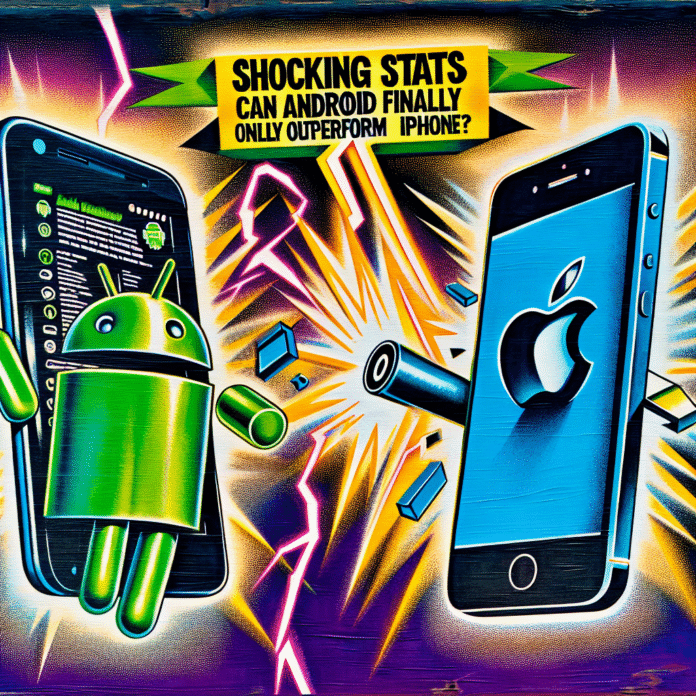Shocking Stats Reveal: Can Android Finally Outperform iPhone?
Picture this: you’re in a bustling coffee shop, and like a scene from a tech-themed movie, almost everyone is glued to their smart devices. You glance around and spot a sea of iPhones, yet you proudly hold your Android, convinced it’s just as content-rich and powerful. Isn’t it amusing how the smartphone debate—iPhone versus Android—has turned into an epic saga? With shocking stats surfacing recently, the question lingers: can Android finally take the crown from iPhone? Let’s dive into the nuances of this heated rivalry.
The Battle of Market Share
First, let’s set the stage with some numbers. As of late 2023, Android commands around 72% of the global smartphone market, while iPhone holds steady at about 27%. This dominance isn’t just luck; it stems from a diverse range of devices tailored to meet all types of user preferences and budgets. From budget-friendly models to cutting-edge flagship devices, Android’s variety is a game-changer in appealing to a broader audience.
Example: Think about it: someone seeking a high-end experience might gravitate toward Google’s Pixel series or Samsung’s Galaxy S lineup, while a first-time smartphone user might opt for a Xiaomi or Realme device that’s both affordable and reliable. This versatility is something that iPhones can’t match, as they strictly define both price and product line.
User Experience and Customization
Customization is where Android often shines brighter than its counterpart. Imagine owning a car where you have the freedom to choose the color, interior style, and even the engine type. That’s the Android experience! Users can tailor everything from wallpapers to home screen layouts, app permissions, and even launchers. In contrast, iPhone users often find themselves confined to Apple’s design choices.
Real-world Use Case: Let’s say you want a minimalistic interface to enhance productivity. An Android user can easily install specialized launchers that streamline their screens for maximum efficiency. An iPhone user, on the other hand, might struggle with the limitations imposed by iOS.
This level of freedom ultimately translates into a unique experience for each Android user, fostering creativity and personal expression.
Performance Across the Board
Over the years, iPhones have built a reputation for smooth performance, often running faster than equivalent Android devices. However, recent developments are turning the tide. Android makers are now equipping their devices with cutting-edge processors that rival Apple’s A-series chips.
For instance, Samsung’s latest Galaxy S series incorporates the Snapdragon 8 Gen 2 chipset, offering industry-leading speed and efficiency. Benchmark tests show that these processors can now handle intensive tasks like gaming and video editing just as seamlessly as iPhones, if not better.
Example: Consider a popular game like “Call of Duty Mobile.” With the right Android device, gamers can enjoy stunning graphics and swift load times that are on par with what iPhone users experience. The gap in gaming performance is closing fast, making Android a compelling option for gaming enthusiasts.
App Store Diversity and Innovation
The Google Play Store is a vast ocean of applications, and while the App Store has its merits, the sheer variety available on Android is noteworthy. From indie developers to big names, the Play Store allows for a wider range of apps and tweaks that enhance user experience.
Moreover, developers are discovering that building for Android can be incredibly rewarding. The growing market share among users invites innovation, resulting in a thriving ecosystem filled with unique applications and tools that can meet niche needs.
- Customization Apps: Platforms like Tasker or IFTTT enable extensive automation capabilities.
- Alternative App Markets: Android users can explore alternative markets like F-Droid for open-source software.
- Flexibility: Users can sideload apps from third-party sources, giving them access to apps that might not be available in the Play Store.
This is a double-edged sword; while it allows for creativity, it also comes with security risks. However, savvy Android users can manage risks with the right precautions.
Price Points that Appeal to Everyone
One aspect where Android truly outshines the iPhone is its range of pricing options. Whether you have a budget of $100 or $1,000, there’s likely an Android device fit for your needs. This flexibility makes it highly accessible, especially in emerging markets where affordability is key.
Insight: Picture a college student juggling tuition, rent, and coffee runs. Opting for a mid-range Android phone doesn’t mean compromising on quality. Brands like OnePlus or Google offer solid performance without the hefty price tag associated with an iPhone.
Conclusion: The Future of Smartphone Rivalry
This ongoing rivalry between Android and iPhone is more than just brand loyalty; it’s a reflection of shifting consumer preferences, technological advancements, and the dynamic nature of the digital world. Android is making strides that will shock both enthusiasts and casual users alike. As manufacturers innovate and statistics continue to evolve, the question remains whether Android will finally outperform iPhone in this captivating saga.
Whether you’re an Android advocate or considering making the switch, one thing’s clear: the smartphone landscape is changing, and Android is stepping up to the challenge like never before.
So, next time you sit in that coffee shop surrounded by iPhones, remember that your Android phone isn’t just a device; it’s a statement of individuality in a world where customization and performance are finally finding common ground.

